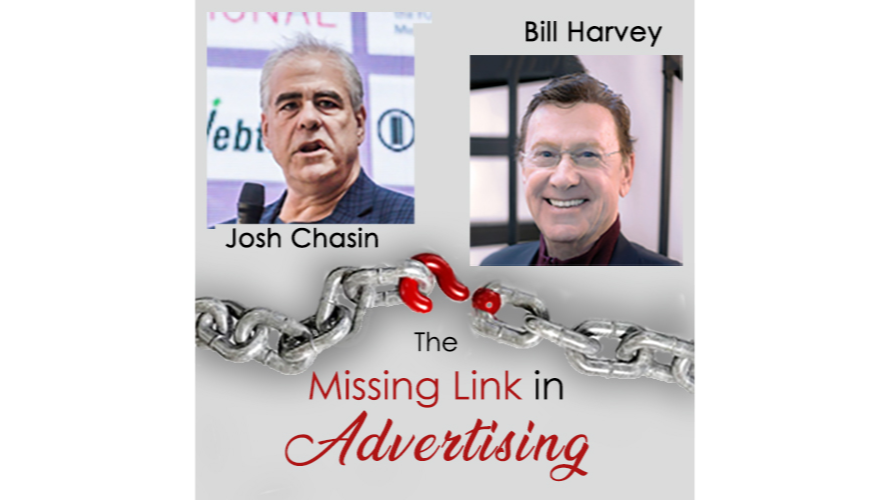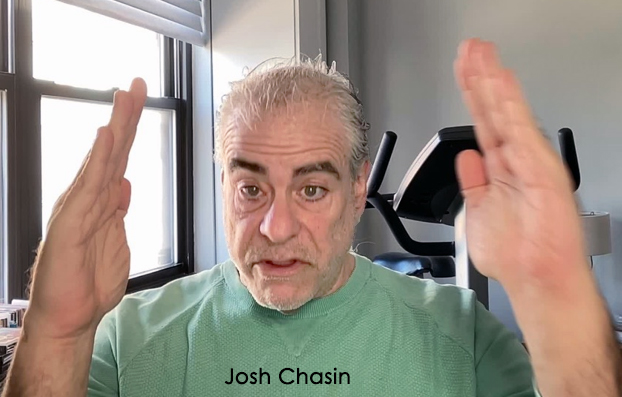Josh Chasin and Bill Harvey Discuss the Missing Link in Advertising

Recently, Josh Chasin became an Advisor to RMT, the tech company of which I am Chairman and Bill McKenna is CEO. Josh and I go way back. He was at Arbitron during the day and doing standup comedy at night back in the ‘80s, and Arbitron was one of my consulting clients. We hit it off immediately back then, both sharing a love of humor and deep thinking. Earlier this year, I sought Josh out and asked him, with his out-of-box perspectives and great communication skills, to help educate the industry about RMT DriverTags, and he accepted the challenge.
Josh: Thanks Bill, you humble me. Of course, back in the mid-80s, stand-up comedy was the “new rock’n’roll,” so of course I wanted in.
There has been a lot of—no pun intended—“attention” paid lately to measurement and quantification of the experience that the consumer has during exposure to ads (and to content). Attentiveness, engagement, “priming” (the extent to which the program environment enhances the performance of the ad). DriverTags are a scientifically developed, analytic tool that facilitates and can help optimize the cognitive experience the consumer has with the ad. RMT has developed and distilled a core set of characteristics—or “drivers”—that can be used to characterize content, ads, and consumers, in order to disentangle the intricate relationships between the three—and at a micro level (THIS consumer; THIS ad; THIS program content.)
Bill: I told Josh how we had used machine learning, set top box data, and an early AI program recommender to find the hidden drivers of why people choose the programs they do. We found 265 psychological variables that explain 76% of the variance in Nielsen ratings which we call DriverTags. I recapped how Howard Shimmel had come up with the idea of Resonance scores, a measure of similarity between the DriverTags in an ad and DriverTags in a program, which Resonance was proven by NCS to cause double digit increases in sales lift, and proven by 605 to cause even larger lifts in branding measures.
Josh: Well to be fair, Bill, you didn’t just tell me—you showed me, with links and papers and findings.
But look, here’s the thing. For years, we’ve conceptualized media exposure in a very “flat” way. The molecule of media exposure is comprised of one screen, and one face.
Now, how many of these molecules are there in your campaign? That’s gross impressions. A million occasions of screen meeting face is a million impressions.
How many different faces? That’s reach.
On average, how many times did each face see the thing on the screen? That’s frequency. And this has been media math since Archibald Crossley first hung out his shingle and started a radio ratings service in 1929.
But for all the seismic changes in audience measurement—notably the advent of Big Data and data science—we haven’t changed media math. It’s still two-dimensional; gross impressions or GRPs are described by the product of reach times frequency, just as sure as the area of a rectangle is length times width.
And for a long time this was enough. But increasingly it’s becoming clear that, for a number of reasons, we need to add a dimension to media math—to make it three dimensional. It’s not that reach and frequency are no longer relevant; it’s that they’re no longer enough.
That third dimension is that thing that goes on between screen and face. The cognitive and emotional response the consumer is having to the stimuli on the screen. We’ve long known that all impressions are not created equal. For years, you could deal with this through tonnage. That’s no longer a luxury anyone in the ecosystem can adfford.
Bill: When I told you the 605 finding that a single impression with at least 30% Resonance could have a substantial effect on purchase intent, do you remember what you said?
Josh: Sure, it was a lightbulb moment. I said “This could mean resonance is more important than Frequency!” That’s why I said that the industry has always thought in two dimensions – reach and frequency – when reality has three dimensions – reach, frequency, and impact – the psychological processes which go on between the screen and the face. Now RMT is proving that impact is probably the most important of all three dimensions. Not just RMT, but also all the attention measurers, biometric and neuro measurers. Impact is the lesson the industry is now trying to learn.
Bill: Click here to see a short video of Josh semiotically getting across the idea of the missing third dimension in advertising media math.

Bill: If you were a television network, how would you use Resonance?
Josh: Probably in two ways—on the content side, and on the ad sales side. In ad sales, let’s recognize that TV viewing is rapidly shifting to streaming,one thing inherent to that migration is going to be a reduction in impression opportunities. The streaming viewer has a lower tolerance for spot load than the linear TV viewer, and all the streaming services seem to be aligning around business models that let you pay to see fewer ads. If there are a relatively fixed number of TV advertisers, and a relatively fixed number of viewers, then we must conclude that frequency suffers. Same number of campaigns, same number of faces, but fewer impressions—that means lower frequency. It’s a tautology.
So at the same time that we can expect campaigns that seek to optimize target reach will have to do so at a lower frequency, we learn that maximizing resonance can be more effective than maximizing frequency. This means TV network companies— or “programmers,” to use the appropriate in-vogue term—can service the needs of the same pool of advertisers, with the same reach, and with the same or better results, by deploying the concept of resonance in impression delivery. Offset the impact of lower frequency with the benefits of resonance.
On the content side, I’d want to look at ways to incorporate resonance into content acquisition. What consumers do I attract now? What resonates with them? Do I want to attract different consumer types, or get stickier with my core viewers? What content types provide synergetic resonance for my biggest advertisers? What content will make ads effective with the least frequency?
Bill: Yes, the Resonance scores predict much higher sales lift for premium video content contexts than for “54321 Skip” YouTube. In an earlier article, I showed that attention measurers using eye tracking tend to show smaller advantages for premium video over YouTube, than are shown by RMT Resonance and by NCS sales effects.
Josh: I don’t want to say anything to disparage the good work that so many are doing with biometrics and response to media. But I will say that I’ve always felt that it’s difficult to make a biometric measurement scale.
Bill: What would you do with Resonance if you were an advertiser in the upfront?
Josh: Well, predictably, the flip side of what I’d do if I were a network. I’d know that I was probably targeting an increasingly precise and elusive customer—in this day and age I’m way more likely to be looking to activate against my own first party data than against, say, Women 25-54. Which means I don’t want to waste a lot of impressions. So I’ll pay more per impression for resonant impressions against my real target, than I would for impressions I buy by the boatload against a broad demographic.
Bill: What would you do with Resonance if you were an agency?
Josh: Well, obviously, the same as if I were an advertiser. But typically, agencies buy bulk inventory in the Upfront, and allocate it later across clients. I’d want to use resonance to do a better job for my clients of matching the right inventory slots to the right brands.
Bill: What would you do with Resonance if you were a research company?
Josh: I’ve spent most of my career at three currency measurement companies—Arbitron, Comscore, and VideoAmp. All three ended up competing with Nielsen in the network TV currency space. So I have a pretty solid sense of what I’d want to do with metrics like resonance. Typically, these companies do two things—measurement, and utility. And by utility, I mean all the things that the data empowers users to do, and which typically reside in the software, the platform, the interface. If I was providing currency measurement—and I WAS providing currency measurement most of the last 35 years—I’d want to onboard resonance data in some fashion to enable it to complement my audience measurement data in order to inform planning, packaging, activation, and measurement.
Bill: Do you have any last things you want to say?
Josh: Yeah, actually I do. Back when we first met, I remember you would say to me, at the end of a conversation, “to be continued.” You still say that today when we speak, and I always loved it, and I consider it a blessing that it has in fact continued for over 35 years and counting.
Bill: Thanks Josh!
Josh: Thanks Bill.
Josh Chasin and Bill Harvey are featured speakers at the ARF’s annual AUDIENCExSCIENCE conference March 20 and 21 in New York City.
Posted at MediaVillage through the Thought Leadership self-publishing platform.
Click the social buttons to share this story with colleagues and friends.
The opinions expressed here are the author's views and do not necessarily represent the views of MediaVillage.org/MyersBizNet.


